Plumbing Vent Piping Tips
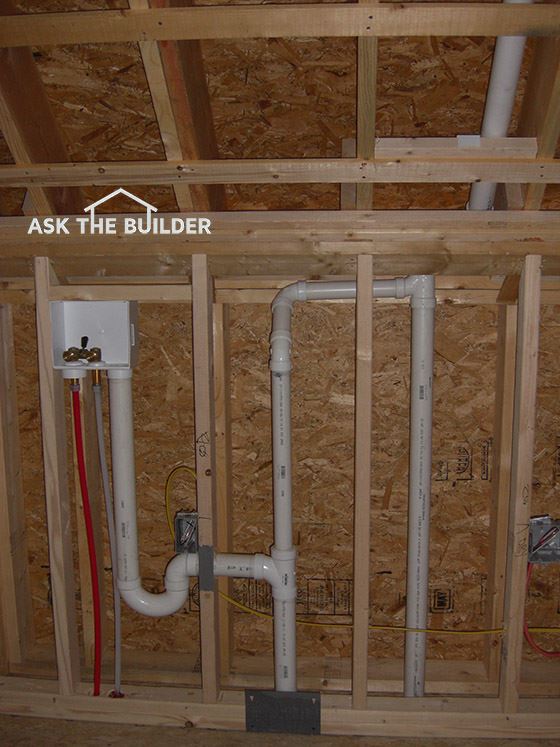
Plumbing Vent Piping | There is more plumbing vent pipe in this photo than drain piping! The fixture on the left is a washing machine drain box. You can see the 2-inch drain pipe leave the box and go into a p-trap. It connects to a 2 x 1.5 x 2 x tee. The vent pipe rising above the tee is just 1.5 pipe and connects to another vent pipe that is coming up from the basement below. That vent pipe leaving the upper right corner of the photo is on its way out through the roof. © 2018 Tim Carter
"Plumbing vent pipe is very important and supplies air from the atmosphere into the drain pipes. The vent pipes must have a slope to drain condensation water."
Revised February 2018
Plumbing Vent Pipe TIPS
- Vent pipes allow air into the plumbing system
- WATCH my Vent Piping video below!
- Each fixture needs to be vented properly
- Vent pipes don't have to be as big as the drain pipe
- CLICK HERE to Get Tim's FREE & FUNNY Newsletter
DEAR TIM: I've got a remodeling project coming up and I intend to do the plumbing work. I'm good to go on the water lines, but the drain lines and plumbing vents are my weak spot.
Can you give me the executive summary on plumbing vents? Is there a failsafe method of venting so that everything will work fine down the road? What are the biggest things to avoid? Mandy P., Portland, ME
DEAR MANDY: You've asked for the impossible. I've been a master plumber since 1979 and I don't know if it's possible to do a Vulcan mind meld between you and me, but I'll give it my best shot.
Plumbing vent pipes often confuse many, and even apprentice plumbers who are somewhat familiar with the trade often make serious mistakes when it comes to plumbing vent systems.
Related Links
Washing Machine Vent-Pipe DIY Diagram
Best Practices Guide For Installing Vent & Drain Pipes
Free & Fast Bids
CLICK HERE to get FREE & FAST BIDS from local plumbers if you want them to install your vents.
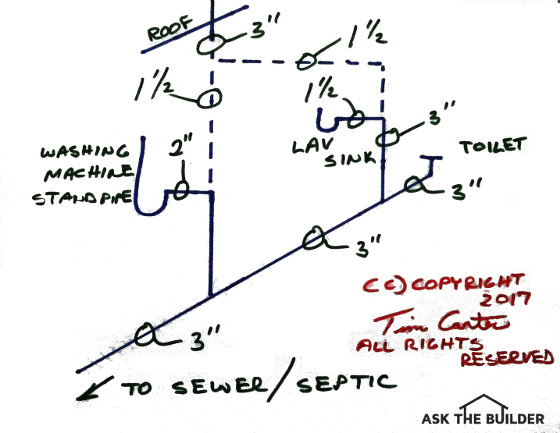
The dashed lines are plumbing vent pipe. Note the pipe sizes. It's very important that a washing machine has a 2-inch drain line up to where it connects to the main stack. Look at the interesting wet venting of the toilet! I'm a master plumber. If you want me to DRAW out your entire plumbing system including pipes sizes and fitting list, CLICK HERE. (C) Copyright 2020 Tim Carter - Master Plumber
Can I Install My Own Plumbing Vent Pipe?
The first thing I want to mention is to make sure you check to see if you're allowed to install the piping. Some states and towns only allow licensed plumbers to do this work. The reasoning is based on public health. If you make mistakes when you plumb, you can get some people seriously ill or even cause death.
For the most part, nothing about residential plumbing is that hard. If you're reasonably intelligent, you'll be able to do the work and grasp the physics principals that are involved.
The absolute best book about much of what you need to know was written by a peer of mine, Rex Cauldwell. You should buy his book:
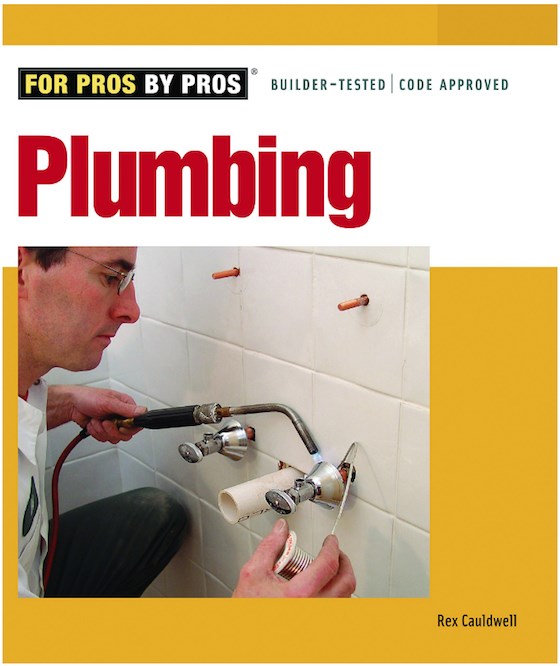
Rex is a peer plumber. This is an exceptional book filled with tips. CLICK THE IMAGE NOW to have the book delivered to your home.
What Happens When Water Flows Down Drain Pipes?
Air is pushed out of the way when water flows down drain pipes. This air must be replaced and that's what a plumbing vent pipe does. It brings air from outside into the entire plumbing system.
To help you understand the need for plumbing vents, let's talk about what happens in drain piping when water travels down through the system. In a properly designed plumbing drain and vent system, there is air in the pipes before water is poured down a drain or a toilet is flushed.
As soon as you introduce water, and lots of it quickly, into a plumbing drain, the dynamics of the air changes. The water surging into the system displaces the air often pushing it down the drain in front of the rushing water. This air needs to be replaced so a vacuum doesn't form in the system.
CLICK HERE to get FREE & FAST BIDS from local plumbers if you want them to install your vents.
Are Vacuums in Plumbing Drains Bad?
Vacuums in plumbing drain lines are bad, very bad. You've possibly heard a vacuum getting satisfied if you've been in a bathroom when a tub or sink drain gurgles when you flush the toilet. At a friend's house, this would happen every time his washing machine would drain.
When the washing machine pump came on, his kitchen sink would gurgle and the water in the trap under the sink would be sucked dry. This allowed sewer gas to enter his house and vermin that are crawling around in the sewer lines. Yuck!!
To prevent traps in downstream fixtures from being sucked dry like my friend's kitchen sink, you install a vent pipe, usually within 3 feet, close to the fixture trap. This vent pipe rises vertically towards the roof where it opens to the atmosphere to get the needed replacement air.
What is the normal size of most vent pipes?
It's important to realize a pipe that's 1.5 inches in diameter is sufficient to vent any residential fixture. But understand that some plumbing codes have very specific sizing requirements.
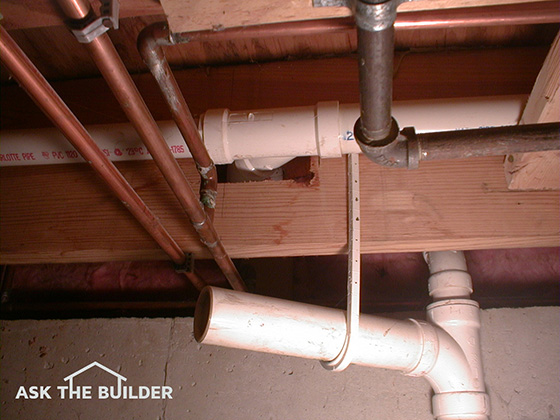
The horizontal white PVC pipe at the bottom of the photo held up by the j-hook is a drain pipe for a shower. It connects to a 2-inch tee against the wall. Out of the top of the tee, you can see a 1 and 1/2 vent pipe extending up into the floor and wall above on its way to the roof. Copyright 2018 Tim Carter
If you start to collect vent pipes from other fixtures as you head to the roof vent, the pipes will have to get bigger, just as plumbing drain lines and building drain pipes get bigger the more water that enters them.
Can a Plumbing Vent Pipe be Small?
Vent pipes can be tiny and work. I'll never forget visiting a farm owned by another master plumber friend of mine. For fun, he vented all of the fixtures in a large bathroom with 1/2-inch copper water lines! Believe it or not, enough air was able to pass through that tiny pipe to satisfy each of the fixtures.
It was just a simple experiment he did as he knew it would never pass an inspection. Lot's of air can pass quickly through a small unobstructed pipe.
WATCH THIS VIDEO NOW:
Should I Vent All Fixtures?
To be safe, extend a vent pipe from every fixture. Certain fixtures can be wet-vented, this means two fixtures share a common vent, but since I can't be at your house to mentor you on this complex technique, just install separate vents for each fixture. Be sure any vent line that has to run horizontally actually has a tilt to it so any condensate water that forms in the pipe drains down to the sewer or septic tank.
Are Studor Vents a Bad Idea?
Studor vents, in my opinion as a master plumber, are a bad idea. They have moving parts and they will eventually fail.
You should install a loop vent instead.
CLICK or TAP HERE to get access to the rest of the video where I show you exactly what to do.
There are many things to avoid when installing plumbing vent pipes. I'm not a huge fan of the mechanical vents that you might install under an island sink or in some other location where running a traditional atmospheric vent is next to impossible. The common name for these vents is air-admittance valves.
That name should be SCREAMING at you. Why? Because a valve has MOVING PARTS
Every mechanical vent I've installed has failed over time. Anything that has a moving part will fail eventually
Can Ice Choke Off Vent Pipe Air?
Yes, ice can choke off a vent pipe. It happens at my own home in bitterly cold weather. This ice is often called hoarfrost.
Mandy, you live in a coastal area, so it doesn't get bitterly cold for too long. But if you live in an area that gets frigid for long periods of time, you have to make sure the vent pipe both above and below the roof is a large pipe, say 4 inches in diameter, so that it doesn't get choked off with frost buildup.
I've seen this happen and it's almost unbelievable to think that ice could form in a vent pipe. It happens because the vent pipe sticking through the roof gets as cold as the air temperature.
If the air temperature is cold enough outdoors, the water vapor traveling up the pipe can freeze right to the sides of the pipe. The ice buildup is the same temperature as the air temperature.
Soon the vent pipe chokes off with ice. This happened to me here at my own home in New Hampshire the winter of 2015-16. I didn't build this house and the plumber just has a 3-inch vent pipe extending through the roof. It should have been 4 inches.
Do I Need a Full-Sized Vent Pipe?
Yes, full-sized vent pipes are a good idea. At least one of the primary 3, or 4-inch, drainage stacks should continue up and through the roof without changing the pipe size. Other smaller vent pipes from other fixtures can connect to this full-sized vent pipe.
Avoid the temptation to eliminate a full-sized vent in your plumbing system. Some new plumbing codes are moving away from full-sized plumbing vents. I'm not a fan of this. A full-sized vent is a primary vent where the drain line transitions at some point and becomes the vent pipe that exits the roof.
In many an older home, this drain pipe is perhaps 4 inches in diameter and stays that size all the way through the roof. Other vent pipes that are smaller may connect to this full-sized vent, and that's perfectly fine.
CLICK HERE to get FREE & FAST BIDS from local plumbers if you want them to install your vents.
Column 883
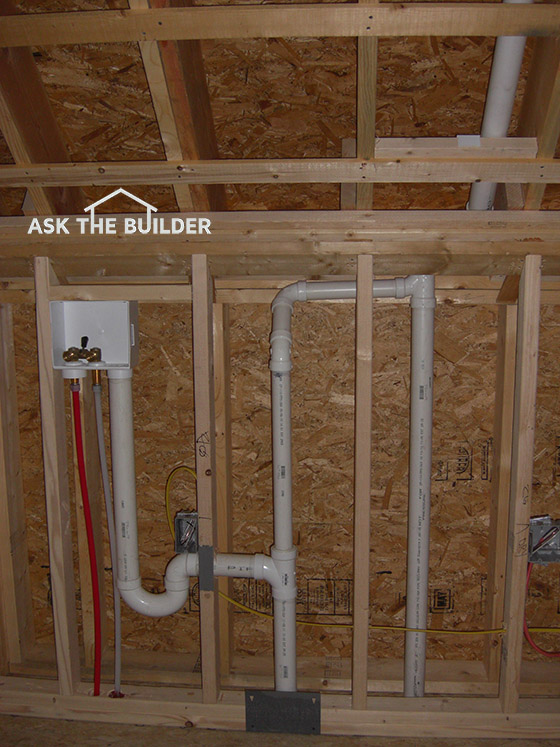

59 Responses to Plumbing Vent Piping Tips